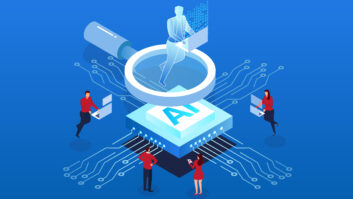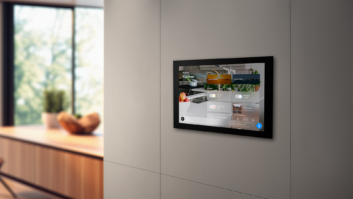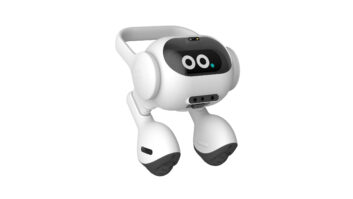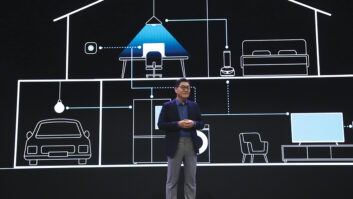The noise surrounding AI has gotten very loud lately, with marketers adding the two letters to their new product promotions in sometimes questionable ways and pundits predicting either a computer-aided utopia or a jobless dystopia. And while it will be some time before smart machines are dexterous enough to replace integrators on-site, there are already many ways that AI is making life better for custom installers — including recent entries from Savant and Josh.ai that use the technology in very different ways.
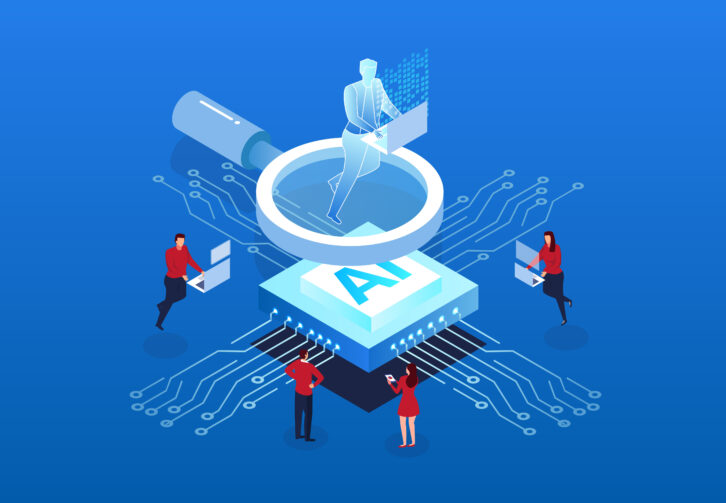
Of course, AI has been a part of the residential integration world for some time, with smart TVs using it to create the best picture for the viewer and security systems using it to react to threats — and avoid non-threats — more reliably, among many other uses. However, these new advances offer a different way of looking at artificial intelligence and the possibilities it offers going forward.
Savant Smart Network
Back in May, Savant introduced its Savant Smart Network, which uses Mist Technology from its partner, Juniper Networks, a global leader in enterprise networking, to constantly analyze and monitor the smart home network and make overnight changes to it so that it operates better, if needed. It also allows for a previously unheard-of level of data coming from the wireless access points.
“When Savant began, we believed that most integrators delivering a good network can do a great job,” says Aaron Gutin, category product director for networking and security at Savant. “The challenge has been that the number of trouble cases we manage annually that are not our hardware and not our software, but are some sort of network-related issue, still happen a lot.”
The solution was to give the human integrators some big data-supported assistance, and Juniper was the right partner for that. “What Juniper has done through its acquisition of a company called Mist Wireless is unlocked a ton of information that’s always been inside the access point as part of the Wi-Fi spec, but there was never a way to get it out of there and put it to good use,” explains Gutin. “We’re looking at a bunch of variables in different combinations and then making decisions about that. If ‘this, then, that’ is the baby version of what AI is, the Savant Smart Network is using bigger sets of data to make decisions.
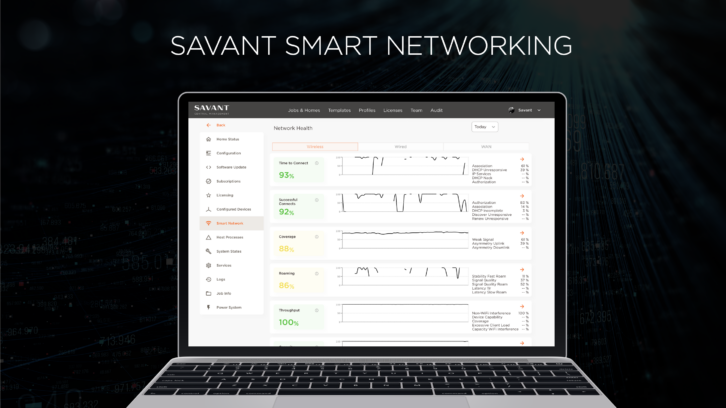
“It’s a tool like anything else, but what’s unique about the Juniper solution is it’s a very targeted tool directed at the plumbing of Wi-Fi. Now you can answer questions such as: Are devices connecting in the time you want them to? Are they failing to connect? Are you getting the coverage you want? Are you using the airspace the way you want to? And, if not, the ‘why’ is available to you in just two or three clicks inside the Mist environment. All of that is using reinforced learning algorithms, machine learning, and AI — which are mutual information processes that learn to associate different bits of data.”
There are those two letters again, but what does AI mean to Gutin? “Actionable information is how we talk about it with dealers,” he says. “It’s not artificial intelligence — it’s actionable information in a few clicks that allows you to move on to the next step of fixing whatever issues are found.”
The Savant Smart Network lets a dealer see every network being managed at a glance. And if you are thinking that even all the homes a large integration company serves isn’t enough to qualify the information as “big data,” you’d be right, but Juniper is providing much more than that — it is pulling from all its client data. “It is a big data offering,” says Gutin. “There is a billion-dollar cloud behind Juniper that runs some of the largest networking infrastructures on the planet. The internet largely runs on Juniper — 99 of the Fortune 100 have a Juniper platform.”
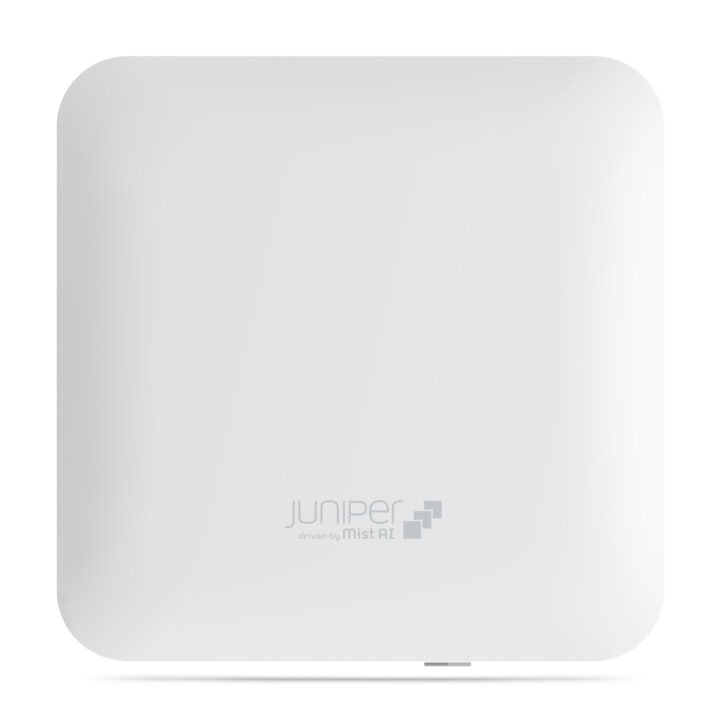
With being part of such a large cloud of information, clients may have security concerns, but Gutin thinks the threat is minimal. “All of this information is just looking at the packet header information, not the actual data,” he says. “This is really looking at the plumbing of Wi-Fi. Of course, we have implemented two-factor authentication, which requires a third-party device attached to their account that adds another layer. Also, it is important to note that Juniper has no reported security issues — ever. And they run some of the largest networks on the planet for some of the largest corporations on the planet.”
Each of the Juniper access points — Savant offers four, three indoor and one outdoor — has an extra radio on board that provides the eyes and ears of the AI, which is named Marvis. Marvis is monitoring 150 states of Wi-Fi for every single client connected to an access point, every minute it’s connected.
“At first, that sounds overwhelming, but obviously it’s only reporting the little things it sees for this, that, and the other every two to three seconds,” explains Gutin. “Every 10 minutes there’s a bunch of information that goes up into the cloud. In the meantime, the other radios onboard the access point are supporting customers, clients are connected, and they’re walking around the house on the bands they should be. In the background, Marvis is gathering information about the resulting experience they’re having inside this wireless network. There’s no other hardware required. Every access point has that extra bit of information and reports to the cloud for itself. The cloud combines all the information, whether there’s 150,000 access points across an entire campus or there’s four access points in somebody’s house.
Related: The Power of AI and Virtual Design
“You can look at the information in the aggregate for the last 60 minutes, yesterday, and up to seven days for any individual client. It uses that information to build a data model of the customer’s RF environment and the common experience that is being had for the last 30 days.
“And every night at 3:00 AM it asks itself, ‘Is the Wi-Fi better or worse today than it was yesterday, or as compared to the last 30 days? Did I make a change that positively or negatively impacted the experience yesterday?’ Then, based on that answer, and because this is an AI in the traditional sense, the aggregate learning that Mist AI cloud is doing over the past eight years it has been running means that every site benefits from every other site’s lesson learned.
“So, we’re all helping each other. The way this works for Savant is that we have utilized the Juniper Mist API and we’ve created an entire front-end experience for our dealer to purchase subscriptions on the day they’re going to deploy. They claim these devices to a site by scanning a QR code, and then they can configure wireless networks right from Savant Central Management.”
Savant Smart Network introduces a new subscription model and recurring revenue opportunity for Savant integrators. “You buy the WAP and it’s $120 per year per access point for a subscription that includes all of the ongoing data analysis, daily optimization, and so on,” says Gutin. “We have a revenue-sharing program with some of our dealers where they earn account credit for every subscription they sell, and they earn that every year that the customer renews.”
As an industry, no one knows automation better than custom installers, so having the performance of the networks that CIs create seems to be a good fit. “It made absolute sense to bring an automated network solution into our ecosystem, especially given what it was proving in the field,” concludes Gutin. “One of the largest IT service providers to the enterprise market reports a 90-plus percent reduction in help desk tickets having moved their entire infrastructure to Juniper. And we want that for our dealers, we want that for ourselves, and we want that ultimately for the end user.”
Josh.ai JoshGPT
ChatGPT is a big reason AI is all over the news and social feeds these days. And while people were debating its accuracy, legality, and usability, Josh.ai was working on a way to incorporate generative AI into its control system to provide clients with deeper, more informative answers to the questions they ask Josh, delivered in a much more human way. The result is the recently released JoshGPT — with GPT meaning generative pre-transformer, the underlying technology that enables large language models (LLMs) to function.
“We’ve had artificial intelligence for decades in many specific ways,” says Alex Capecelatro, CEO of Josh.ai. “What we’re moving toward is this notion of AGI — artificial general intelligence. AGI is the concept that you don’t have to train the program on the specific problem it’s solving, but instead you have a general artificial intelligence that can approach a problem it’s never seen before and use logic to figure out. This is the first time we’re starting to see that type of AGI.
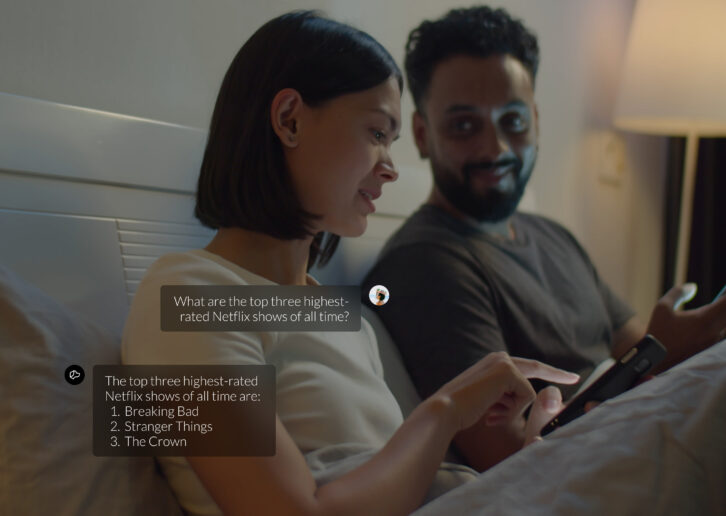
“We have customers who will walk into the kitchen and have no idea what problem awaits them, but you can now ask the system for assistance. It might be, ‘How long should I reheat my leftovers from last night?’ The system can tell you. We don’t know the problems that our customers are going to want to have solved today, but we now have a product that can offer solutions or at least recommendations on all sorts of things.”
JoshGPT, which is now available as a free update to all Josh customers, uses Josh Micro and Nano as contextually aware far-field microphones that clients can naturally talk to and get in-depth answers to their questions delivered in full, descriptive sentences — not just the results of a Google search. From the Josh App, customers can tap on the voice button or text commands to access JoshGPT anywhere.
Josh.ai clients can also combine natural home control and dynamic assistance in a single request, such as, “Okay, Josh, can you turn on the kitchen lights and tell me a quick recipe for chicken enchiladas?”
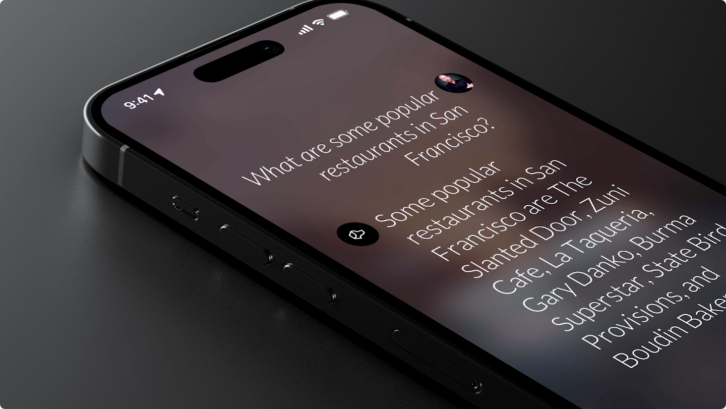
“We’re using machine learning algorithms everywhere,” says Capecelatro. “We take the audio that’s coming in, clean it up from background noise, and then convert the audio to speech through a process called automatic speech recognition. We’re taking that text and figuring out parts of speech and meaning and actions with our contextual natural language processing. There’s a lot of work we do around what we call the knowledge graph.
“We think that some of these new large language models will help us do an even better job because that’s a hard problem. Turn on ‘X’ is a very ambiguous statement. For example, ‘Turn on the lights.’ There’s an artist called Lights. There’s a song by Kanye West called ‘The Lights.’ There’s probably a TV show called The Lights somewhere. We basically have hard-coded it for ‘lights, shades, fireplaces, fans’ — things that we know to execute the device command because we’re a home automation company. But you shouldn’t ultimately have to hard code that stuff. There are times when you ask for certain things and we don’t always do it right on the first attempt. We believe that incorporating some of the large-language-models technology will make other aspects of Josh a lot smarter.
“We’ve made it so any ‘open, close, turn-on, turn-off’-type commands get special treatment. On the flip side, though, we’ve had the ability to answer lots of questions like ‘Who is George Washington?’ or ‘Who is the president of France?’ What we found is when you would say something like, ‘Who is Steve Jobs?’ our response gave priority to JoshGPT because the GPT response is going to be a lot better. We always go to GPT when people are asking about a person because they’re much more likely to get it right than us.”
When dealing with generative AI, there are sometimes issues with inaccuracies, as the AI chatbot pulls from across the internet, mixing reliable sources with those that may have suspect information. Capecelatro doesn’t see this as posing too much of an issue for JoshGPT users.
“In terms of the GPT responses, we make sure the clients know that it’s possible they might get some inaccurate information,” he says. “Don’t make big decisions based on this. But I will say from GPT 3 to 3.5 to 4 it has gotten over an order of magnitude more accurate in terms of the false data points that it gives.
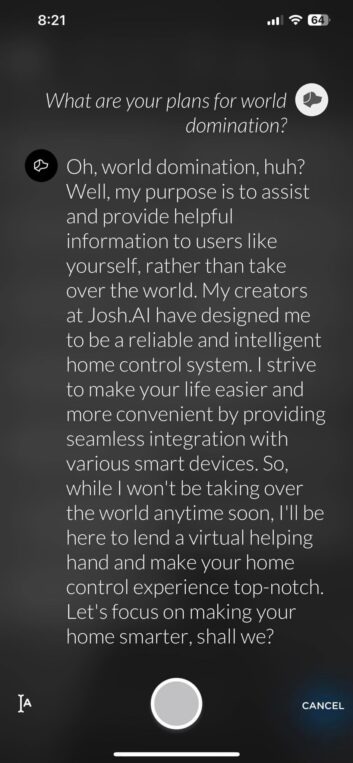
“GPT 4 still claims not to have data more recent than November 2021. I say, ‘claims’ because there are examples where they obviously do have data that’s more recent, but, generally, if you ask a question like, ‘Who won the baseball game last night?’ it’s going to say, ‘I don’t have accurate information, my data only goes up to November 2021.’ That is a caveat that the end consumer is not going to tolerate. Plus, it doesn’t feel right that you can say, ‘Close the shades, tell me about the founding of America, and who won the baseball game?’ and it can do the first two but not the third. We do think that there will be real-time data capabilities before the year is over, but that’s still a gap. That’s something that we don’t have a good solution for today.”
Generative AI seems to be progressing at a rapid rate, but Capecelatro leans on that “seems.” “I think there was definitely a step function with OpenAI and what’s going on today, but people who work in building generative AI will tell you that wasn’t an overnight success,” he says. “Version 3.5 was the first time most people used it, but they had released the original OpenAI around five years prior, and no one cared. No one cared about the second version either. It kept making these small improvements. This year is just a little better than last year, which was a little better than the year before. But it’s gotten to a point where most people didn’t know what was going on five years ago, so, it feels like overnight this thing just came out and it blew their minds.”
That falls in line with the last time Residential Systems spoke to Capecelatro about the progress of AI, back in June 2020, when he said: “Over the next 12 months, if you find that an AI system doesn’t always do the right thing, that’s all going to incrementally be improving, but things will not be fundamentally different. Five to ten years out? Hardware is evolving, software is evolving, data is evolving. I think things will begin to look pretty different in that timeframe.”
He continues to stand by that statement.
“We started the company in 2015. We recently hit eight years and we had the name ‘AI’ in the company from the get-go, so, we’ve been focusing on this for a long time now,” he says. “I can tell you with full conviction that every single year I felt like things didn’t move forward as much as I wanted — the business did, but the technology did not. It was always this feeling of we know there’s so much more that we can be doing.
“I still stand by saying, ‘every year there are incremental improvements, there aren’t these big radical changes,’ but over the eight years that we’ve been in business, I couldn’t imagine the stuff we’re doing today. It is interesting to think I know exactly what my company is releasing in 2023, probably in 2024, and like 50 percent conviction for 2025. I have no idea what we’re going to be releasing in 2028, 2029, and 2030, but that’s not that far away — only seven years out.
“I have a lot of confidence that by 2030 we’re going to live in a world that feels crazy science fiction-y. It’s going to be unreal.”
